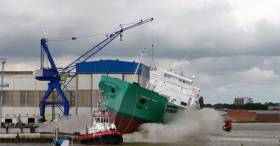Displaying items by tag: Newbuild launch
#shipping - Following last month's media headlines on Arklow Shipping and its relationship with Seaborne Freight which the UK Government had earmarked among firms to alleviate freight capacity in the event of a no-deal Brexit, the Irish company today added another newbuild, writes Jehan Ashmore.
The newcomer, Arklow Wind (see YouTube) was launched this morning after a christening ceremony was held in Leer, Germany. The shipbuilder, Ferus Smit Leer GmBH is where Arklow Wave the leadship of a quartet (or 'W' class), as Afloat previously reported was launched last year and entered service in October.
Arklow Wind at 16,500dwt is an enlarged version of the 8,500dwt ships that Ferus-Smit delivered to ASL in the past. The 149m newbuild bulker has two box shaped holds with a cargo capacity of 700,000cft hold volume.
Propulsion is achieved through a 3840kW main engine in order to achieve low fuel consumption. As for the associated propeller, this involves a duct for enhanced thrust at lower speeds and reduction of maximum installed propulsion power.
Arklow Wave which has been given an Iceclass 1A certification, is set to be delivered in April to the expanding Co. Wicklow based dry-cargo operator whose fleet exceeds more than 50 vessels. The name revives a predeccessor which was disposed as the final of the older W class all built outside Europe. This was a first for ASL when the order was contracted to a South Korean yard.
The majority of the fleet is Irish flagged while the rest of the ships are part of ASL's Dutch division, Arklow Shipping Nederland B.V. based in Rotterdam. Europe's largest port is also used as a port of registry for these vessels.
On a related note to the Seaborne Freight saga, the Dutch flagged Arklow Bank likewise built by Ferus Smit (Westerbroek yard in The Netherlands) featured on Channel 4's News coverage on Seaborne Freight. Controversary arose following the UK's Transport Secretary's cancellation of a contract to Seaborne to operate the Ramsgate-Ostend, Belgium route.
In addition Arklow Bank the leadship of the 'B' class series dating to 2014, this week docked in Dublin Port. By coincidence the vessel berthed at the same South Bank Quay to where Afloat's follow-up (photo) coverage was taken in relation to the Seaborne story broadcast on the UK TV news programme.
Dutch Yard's 'Bloomsday' Launch of Arklow Venture
#Launch – Once again it was a Dutch yard that launched a cargoship for Arklow Shipping and that took place on this Bloomsday morning, writes Jehan Ashmore.
Arklow Venture with yard no. 727 represents the seventh so far of 10 ‘V’ class ordered to the Royal Bodewes yard from their own designed Eco-Traders.
The launch of Arklow Venture brings to more than 50 ships of the joint Irish and Dutch flagged fleet. They comprise of short-sea dry cargoships to bulk-carriers.
Arklow Venture has a 87m long hull that features a straight-stem bow. The design reduces wave resistance and so saves on fuel consumption adding to greater efficiencies.
As previously reported, a sister Arklow Vanguard was delivered last month having also been completed at the yard located in Hoogezand near Groningen.
The V class are all Dutch flagged and are managed by Arklow Shipping Nederland B.V. Among the typical cargoes theses sisters ships will transport will be grain, animal feed and steel rails.






























































